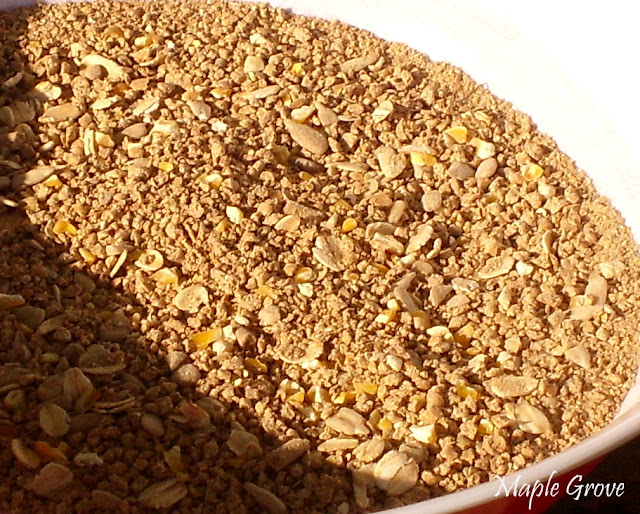Breed selection
To start with, if you live in a climate where it gets cold in the winter, you'll want to select cold-hardy breeds for your flock. There are many to consider, such as Barred Rocks, Delawares, Orpingtons, Australorps, Silkie Bantams, Wyandottes, Rhode Island Reds, New Hampshire Reds, Brahmas, Favorolles, and for a rainbow of eggs tinted blue, pink, green or dark brown: Easter Eggers, Ameraucanas, and Marans. My Pet Chicken website has a handy online breed selector tool to help you make a selection to suit your specific needs. (Meet our flock.)
 |
| From left to right: Delaware, Buff Orpington, Black Australorp, Silver Laced Wyandotte, Rhode Island Red, New Hampshire Red |
Suitable shelter
Chickens need proper shelter from the wind, rain, snow, and cold. Our hen house is not insulated, and we don't use heat lamps. It is, however, free from drafts and well-ventilated. This is really important to keep the flock healthy. Any cracks or holes that allow cold air to blow directly on the chickens should be sealed. Chickens have feathers and down that are natural insulators and keep their bodies warm, but drafts can blow that warmth away.
On the other hand, the shelter does need proper ventilation to keep the chickens healthy. Chickens give off moisture from their respiration and droppings. If the coop is not ventilated, this moisture can cause freezing conditions. The droppings can give off ammonia if the moisture begins to decompose it. Ventilation (usually screened openings) should be placed above roost level on opposite walls of the coop to provide cross-ventilation, allowing moisture to escape and fresh air to replace the old. The more chickens that are in the coop, the more ventilation you will need. Our coop is 6'x8'. We have four ventilation openings (two each on opposite sides) cut into the underneath side of the overhangs and covered with screening material and register covers.
Deep litter bedding
We use the deep litter system of bedding in our hen house. When we clean out the house in the fall, we place a deep layer of straw on the floor for added warmth. If needed, we could use a pitch fork to loosen and turn it occasionally, but the chickens actually do a pretty good job of that themselves with their scratching. Our hen house has a poop pit under the roost, so most of their droppings accumulate there, keeping the floor clean. You can read about our hen house design here.
Supplemental scratch mix
We feed our chickens a layer mix year-round; they also free-range for all those good nutrients found in insects and greens. Even in the winter months we let the chickens out to forage. There is not as much food for them to find at this time of year, though, so twice a day we give them a scoop of a scratch mix in addition to their regular feed. We make up the mix ourselves with cracked corn, oats, sunflower seeds, and flax seeds. The digestive process of eating this scratch produces an energy that also helps to keep them warm.
Fresh water
Chickens drink a lot of water and should always have a fresh supply to keep them hydrated. This helps keep them warm and healthy and contributes to the proper functioning of all their body systems, including respiratory, digestive, and reproductive. The temperatures in our area dip below freezing frequently in the winter. If we had electric in our hen house, we could use a poultry water heater base under the feeder to prevent the water from freezing. Since we don't have electric available, we have two water feeders and switch a warm one for the frozen one in the morning and again later in the day. We have not found this to be an inconvenience, as we check on the chickens two or three times a day anyway.
Other considerations
Egg production
A hen's egg production will decrease or even stop in the winter when there are fewer hours of daylight. Some people put a light in the coop for a few hours in the evening to maintain egg production. We personally feel that nature should be allowed to take its course and that the hen's energy should be directed toward staying warm. We keep six hens and have never been without an adequate supply of fresh eggs in the winter months.
Free ranging
When we get a snowfall, we clear some paths on our property to give our chickens an area where they can come outside for some free-ranging. This daily exercise is good for them and helps them stay warmer. For the most part, we let our chickens decide if they want to come out of the hen house to free-range. If it's too cold or the snow is too deep, they would usually choose not to come out, but in those conditions we don't even give them the option. Sometimes the snow is too deep in their run to even give them access there.
Frozen combs and wattles
A chicken's comb or wattles can become frostbitten in freezing temperatures. When they roost they sit on their feet, and hens will tuck their heads under their wings. Roosters are particularly vulnerable, as they don't tuck their heads in. You can rub a little bit of petroleum jelly on those tender areas to protect them. Frostbite is very painful and irreversible, so you'll want to take safeguards when there is such a threat.
Keeping chickens, as with any animals, requires being aware of and attentive to their conditions and needs at all times. We have had great success at keeping chickens through the winter months by following these simple common-sense guidelines.
Read more about keeping chickens.








